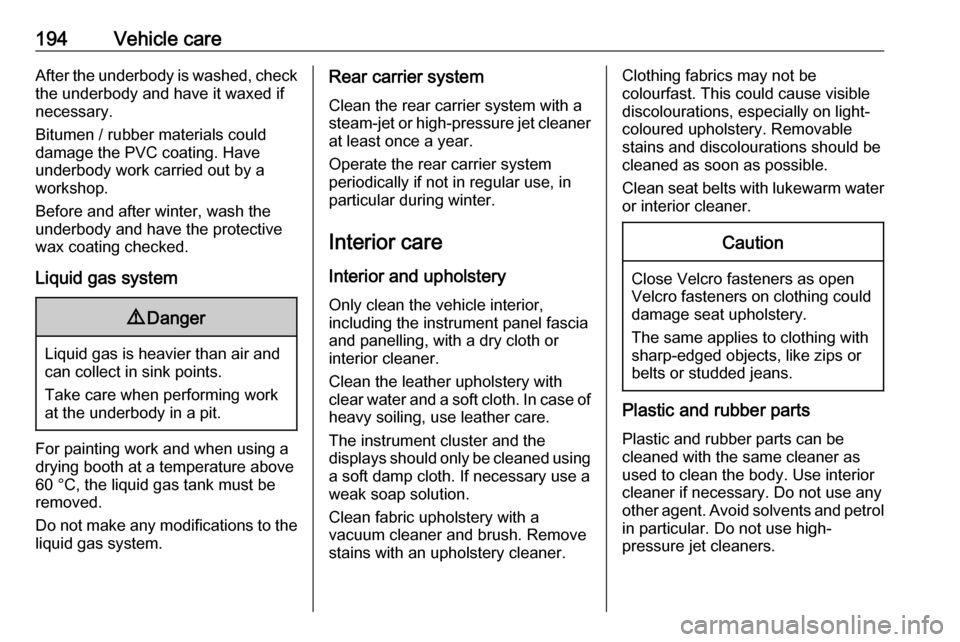belt VAUXHALL ADAM 2019 Owner's Guide
[x] Cancel search | Manufacturer: VAUXHALL, Model Year: 2019, Model line: ADAM, Model: VAUXHALL ADAM 2019Pages: 223, PDF Size: 6.54 MB
Page 97 of 223

Instruments and controls95breakdown, a flat tyre and empty fuel
tank, press Z to establish a
connection to an advisor.
Emergency services
In the case of an emergency situation,
press [ and talk to an advisor. The
advisor then contacts emergency or
assistance service providers and
directs them to your vehicle.
In the case of an accident with
activation of airbags or belt
tensioners, an automatic emergency
call is established. The advisor is
immediately connected to your
vehicle to see whether help is
needed.
Wi-Fi hotspot
The Wi-Fi hotspot of the vehicle
provides internet connectivity with a
maximum speed of 4G/LTE.
Notice
The Wi-Fi hotspot functionality is not
available for all markets.
Notice
Some mobile devices connect to Wi- Fi hotspots automatically and use
mobile data capacity in thebackground, even if they are not in use. This includes automatic
updates, downloads, as well as
programme or app synchronisation
traffic. The data volume purchased
via OnStar might be consumed
rapidly. Turn off automatic
synchronisations in the settings of
your device.
Up to seven devices may be
connected.
To connect a mobile device with the
Wi-Fi hotspot:
1. Press j and then select Wi-Fi
settings on the Info Display. The settings displayed include the
Wi-Fi hotspot name (SSID),
password and connection type.
2. Start a Wi-Fi network search on your mobile device.
3. Select your vehicle hotspot (SSID) when listed.
4. When prompted, enter the password on your mobile device.
Notice
To change the SSID or password,
press Z and talk to an advisor or log
in to your account.To switch off the Wi-Fi hotspot
functionality, press Z to call an
advisor.
Smartphone app
With the My Vauxhall smartphone
app, some vehicle functions can be
operated remotely.
The following functions are available: ● Lock or unlock vehicle.
● Honk horn or flash lights.
● Check fuel level, engine oil life and tyre pressure (only with tyre
pressure monitoring system).
● Send navigation destination to the vehicle, if equipped with a
built-in navigation system.
● Locate vehicle on a map.
● Manage Wi-Fi settings.
To operate these functions, download the app from App Store ®
or
Google Play™ Store.
Page 116 of 223

114Climate control
Direct the flow of air by tilting and
swivelling the slats.
9 Warning
Do not attach any objects to the
slats of the air vents. Risk of
damage and injury in case of an
accident.
Fixed air vents
Additional air vents are located
beneath the windscreen and door windows and in the foot wells.
Maintenance
Air intake
The air intake in front of the
windscreen in the engine
compartment must be kept clear to
allow air intake. Remove any leaves,
dirt or snow.
Air conditioning regular
operation
In order to ensure continuously
efficient performance, cooling must
be operated for a few minutes once a
month, irrespective of the weather
and time of year. Operation with
cooling is not possible when the
outside temperature is too low.
Service For optimal cooling performance, it is recommended to annually check the
climate control system, starting
three years after initial vehicle
registration, including:
● functionality and pressure test
● heating functionality
● leakage check
● check of drive belts
● cleaning of condenser and evaporator drainage
● performance check
Notice
Refrigerant R-134a contains
fluorinated greenhouse gases.
Page 121 of 223

Driving and operating119Indication
An Autostop is indicated by the
needle at the AUTOSTOP position in
the tachometer.
During an Autostop, the heating and
brake performance will be
maintained.
Conditions for an Autostop
The stop-start system checks if each
of the following conditions is fulfilled:
● The stop-start system is not manually deactivated.
● The bonnet is fully closed.
● The driver's door is closed or the driver's seat belt is fastened.
● The vehicle battery is sufficientlycharged and in good condition.
● The engine is warmed up.
● The engine coolant temperature is not too high.
● The engine exhaust temperature is not too high, e.g. after driving
with high engine load.
● The ambient temperature is above -5 °C.
● The climate control system allows an Autostop.
● The brake vacuum is sufficient.
● The self-cleaning function of the exhaust filter is not active.
● The vehicle was driven at least at
walking speed since the last
Autostop.
Otherwise an Autostop will be
inhibited.
Certain settings of the climate control
system may inhibit an Autostop. See
'Climate control' chapter for more
details 3 109.
Immediately after motorway driving,
an Autostop may be inhibited.New vehicle running-in 3 116.
Vehicle battery discharge protection To ensure reliable engine restarts,
several vehicle battery discharge
protection features are implemented
as part of the stop-start system.
Power saving measures
During an Autostop, several electrical
features, e.g. the rear window
heating, are disabled or switched into a power saving mode. The fan speed
of the climate control system is
reduced to save power.
Restart of the engine by the driverVehicles with manual transmission:
Depress the clutch pedal to restart the
engine.
The engine start is indicated by the
needle at the idle speed position in
the tachometer.
If the selector lever is shifted out of
neutral before depressing the clutch
first, control indicator - illuminates
or is shown as a symbol in the Driver Information Centre.
Control indicator - 3 76.
Page 122 of 223

120Driving and operatingRestart of the engine by the stop-
start system
The selector lever must be in neutralto enable an automatic restart.
If one of the following conditions
occurs during an Autostop, the
engine will be restarted automatically
by the stop-start system:
● The stop-start system is manually deactivated.
● The bonnet is opened.
● The driver's seat belt is unfastened and the driver's door
is opened.
● The engine temperature is too low.
● The charging level of the vehicle battery is below a defined level.
● The brake vacuum is not sufficient.
● The vehicle is driven at least at walking speed.
● The climate control system requests an engine start.
● The air conditioning is manually switched on.If the bonnet is not fully closed, awarning message is displayed in the
Driver Information Centre.
If an electrical accessory, e.g. a
portable CD player, is connected to
the power outlet, a brief power drop during restart might be noticeable.
Parking9 Warning
● Do not park the vehicle on an
easily ignitable surface. The
high temperature of the
exhaust system could ignite the
surface.
● Always apply the parking brake. Activate the parking
brake without pressing the
release button. Apply as firmly
as possible on a downhill slope
or uphill slope. Depress brake
pedal at the same time to
reduce operating force.
● Switch off the engine.
● If the vehicle is on a level surface or uphill slope, engage
first gear before removing the ignition key. On an uphill slope, turn the front wheels away from
the kerb.
If the vehicle is on a downhill
slope, engage reverse gear
before removing the ignition
key. Turn the front wheels
towards the kerb.
● Close the windows and the sunroof.
● Remove the ignition key from the ignition switch. Turn the
steering wheel until the
steering wheel lock is felt to
engage.
● Lock the vehicle.
● The engine cooling fans may run
after the engine has been
switched off 3 150.
Page 173 of 223

Vehicle care171In accordance with country-specific
regulations, affix the speed sticker in
the driver's field of view.
Tyre designations E.g. 195/55 R 16 95 H195:tyre width, mm55:cross-section ratio (tyre height
to tyre width), %R:belt type: RadialRF:type: RunFlat16:wheel diameter, inches95:load index e.g. 95 is equivalent
to 690 kgH:speed code letter
Speed code letter:
Q:up to 100 mphS:up to 112 mphT:up to 118 mphH:up to 130 mphV:up to 150 mphW:up to 168 mph
Choose a tyre appropriate for the
maximum speed of your vehicle. Refer to the EEC Certificate of
Conformity provided with your vehicle
or other national registration
documents. Optional equipment
could reduce the maximum speed of
the vehicle.
Directional tyres Directional tyres must be mounted so
that they rotate in the correct
direction. The proper rotation
direction is indicated by a symbol
(e.g. an arrow) on the sidewall.
Tyre pressure
Check the pressure of cold tyres at least every 14 days and before any
long journey. Do not forget the spare
wheel.
This also applies to vehicles with tyre pressure monitoring system.
Tyre pressure 3 206.
The tyre pressure information label
on the right door frame indicates the original equipment tyres and thecorrespondent tyre pressures.
The tyre pressure data refers to cold
tyres. It applies to summer and winter tyres.
The ECO tyre pressure serves to
achieve the smallest amount of fuel
consumption possible.
Incorrect tyre pressures will impair
safety, vehicle handling, comfort and
fuel economy and will increase tyre
wear.
Page 196 of 223

194Vehicle careAfter the underbody is washed, checkthe underbody and have it waxed if
necessary.
Bitumen / rubber materials could
damage the PVC coating. Have
underbody work carried out by a
workshop.
Before and after winter, wash the
underbody and have the protective
wax coating checked.
Liquid gas system9 Danger
Liquid gas is heavier than air and
can collect in sink points.
Take care when performing work
at the underbody in a pit.
For painting work and when using a
drying booth at a temperature above
60 °C, the liquid gas tank must be
removed.
Do not make any modifications to the
liquid gas system.
Rear carrier system
Clean the rear carrier system with a
steam-jet or high-pressure jet cleaner
at least once a year.
Operate the rear carrier system
periodically if not in regular use, in
particular during winter.
Interior care
Interior and upholstery
Only clean the vehicle interior,
including the instrument panel fascia
and panelling, with a dry cloth or
interior cleaner.
Clean the leather upholstery with
clear water and a soft cloth. In case of heavy soiling, use leather care.
The instrument cluster and the
displays should only be cleaned using
a soft damp cloth. If necessary use a
weak soap solution.
Clean fabric upholstery with a
vacuum cleaner and brush. Remove
stains with an upholstery cleaner.Clothing fabrics may not be
colourfast. This could cause visible
discolourations, especially on light- coloured upholstery. Removable
stains and discolourations should be
cleaned as soon as possible.
Clean seat belts with lukewarm water or interior cleaner.Caution
Close Velcro fasteners as open
Velcro fasteners on clothing could damage seat upholstery.
The same applies to clothing with
sharp-edged objects, like zips or
belts or studded jeans.
Plastic and rubber parts
Plastic and rubber parts can be
cleaned with the same cleaner as
used to clean the body. Use interior cleaner if necessary. Do not use any
other agent. Avoid solvents and petrol
in particular. Do not use high-
pressure jet cleaners.
Page 215 of 223

Customer information213Operating data in the vehicleControl units process data for
operation of the vehicle.
This data includes, e.g.: ● vehicle status information (e.g. speed, movement delay, lateral
acceleration, wheel rotation rate,
"seat belts fastened" display)
● ambient conditions (e.g. temperature, rain sensor,
distance sensor)
As a rule such data is transient, not
stored for longer than an operational
cycle, and only processed on board
the vehicle itself. Control units often
include data storage (including the
vehicle key). This is used to allow
information to be documented
temporarily or permanently on vehicle
condition, component stress,
maintenance requirements and
technical events and errors.Depending on technical equipment
levels, the data stored is as follows:
● system component operating states (e.g. fill level, tyre
pressure, battery status)
● faults and defects in important system components (e.g. lights,brakes)
● system reactions in special driving situations (e.g. triggering
of an airbag, actuation of the
stability control systems)
● information on events damaging the vehicle
● for electric vehicles the amount of
charge in the high-voltage
battery, estimated range
In special cases (e.g. if the vehicle
has detected a malfunction), it may be
necessary to save data that would
otherwise just be volatile.
When you use services (e.g. repairs,
maintenance), the operating data
saved can be read together with the
vehicle identification number and
used where necessary. Staff working
for the service network ( e.g. garages,
manufacturers) or third parties (e.g.breakdown services) can read the
data from the vehicle. The same
applies to warranty work and quality
assurance measures.
Data is generally read via the OBD
(On-Board Diagnostics) port
prescribed by law in the vehicle. The operating datawhich is read out,
documents the technical condition of
the vehicle or individual components
and assists with fault diagnosis,
compliance with warranty obligations
and quality improvement. This data,
in particular information on
component stress, technical events,
operator errors and other faults, is
transmitted to the manufacturer
where appropriate, together with the
vehicle identification number. The
manufacturer is also subject to
product liability. The manufacturer
potentially also uses operating data
from vehicles for product recalls. This
data can also be used to check
customer warranty and guarantee
claims.
Fault memories in the vehicle can be
reset by a service company when
carrying out servicing or repairs or at
your request.
Page 218 of 223

216IndexAAccessories and vehicle modifications .......................... 148
Adjustable air vents ...................113
Airbag and belt tensioners ...........75
Airbag deactivation ................43, 75
Airbag label................................... 38 Airbag system .............................. 38
Air conditioning regular operation ................................ 114
Air conditioning system .............. 107
Air intake .................................... 114
Air vents...................................... 113
Antilock brake system ................ 123
Antilock brake system (ABS) .......77
Anti-theft locking system .............. 25
Appearance care ........................191
Ashtrays ....................................... 67
Automatic anti-dazzle ..................27
Automatic light control .................99
Automatic locking ........................23
Autostop ..................................... 118
B Battery discharge protection ......105
Battery voltage ............................. 89
Belts.............................................. 36
Bonnet ....................................... 150
Brake and clutch fluid .................196
Brake and clutch system .............76Brake assist ............................... 125
Brake fluid .................................. 153
Brakes ............................... 123, 153
Breakdown.................................. 190
Bulb replacement ....................... 155
C Capacities .................................. 205
Catalytic converter .....................122
Central locking system ................21
Changing tyre and wheel size ...176
Charging system .......................... 75
Child restraint installation locations ................................... 48
Child restraints.............................. 45
Child restraint systems ................45
Cigarette lighter ........................... 67
City mode ................................... 128
Climate control ............................. 15
Climate control systems .............106
Clock ............................................ 65
Code ............................................. 87
Control indicators.......................... 72
Control of the vehicle .................115
Controls ........................................ 61
Convex shape .............................. 26
Coolant and antifreeze ...............196
Cruise control ...................... 79, 129
Cupholders .................................. 51
Curtain airbag system .................. 43
Page 220 of 223

218Instrument panel overview ........... 10
Interior care ............................... 194
Interior lighting ............................ 102
Interior lights ...................... 102, 164
Interior mirrors .............................. 27
Introduction .................................... 3
J Jump starting ............................. 188
K Key, memorised settings ..............21
Keys ............................................. 19
Keys, locks ................................... 19
L Lashing eyes ............................... 56
Light switch .................................. 98
Load compartment ................24, 53
Load compartment cover .............54
Loading information .....................58
Low fuel ....................................... 79
LPG .............................. 69, 144, 200
M Malfunction indicator light ............76
Manual anti-dazzle ......................27
Manual transmission .................. 123
Memorised settings ......................21
Midlevel Display............................ 80Mirror adjustment ........................... 8
Misted light covers .....................102
N
New vehicle running-in ..............116
Number plate light .....................163
O Object detection systems ...........132
Odometer ..................................... 68
Oil, engine .......................... 196, 200
OnStar .......................................... 93
Operate pedal ............................... 76
Outside temperature ....................64
Overrun cut-off ........................... 118
P Parking ................................ 17, 120
Parking assist ...................... 77, 132
Parking brake ............................ 124
Parking lights ............................. 101
Particulate filter ........................... 121
Performing work ........................150
Power outlets ............................... 66
Power steering.............................. 77
Power windows ............................ 27
Puncture ..................................... 182R
Radio Frequency Identification (RFID) ..................................... 215
Radio remote control ...................20
REACH ....................................... 210
Rear floor storage cover ..............55
Rear fog light ...............79, 101, 159
Rear storage ................................. 54
Rear window wiper and washer ..63
Recommended fluids and lubricants ........................ 196, 200
Refuelling ................................... 144 Registered trademarks ...............212
Retained power off .....................117
Reversing lights .........................102
Ride control systems ..................125
Roof load ...................................... 58
Roof rack ..................................... 58
S Safety belts ................................... 36
Seat adjustment ....................... 7, 33
Seat belt ........................................ 8
Seat belt reminder .......................74
Seat belts ..................................... 36
Seat folding .................................. 34
Seat heating ................................. 35
Seat position ................................ 32
Service ....................................... 114 Service display ............................ 71
Page 221 of 223

219Service information ....................195
Service vehicle soon .................... 76
Side airbag system ......................42
Side blind spot alert ....................141
Sidelights ...................................... 98
Side turn lights ........................... 162
Software acknowledgement .......210
Spare wheel ............................... 182
Speed limiter............................... 130
Speedometer ............................... 68
Starting and operating ................116
Starting off ................................... 16
Starting the engine ....................117
Steering ...................................... 116
Steering wheel adjustment ......9, 61
Steering wheel controls ...............61
Stop-start system........................ 118
Storage ......................................... 51
Storage compartments .................51
Sunroof ........................................ 29
Sun visors .................................... 29
Symbols ......................................... 4
T Tachometer ................................. 68
Tail lights ................................... 159
Three-point seat belt .................... 37
Tools .......................................... 169
Towing ........................................ 190
Towing the vehicle .....................190Traction Control system ............. 125
Transmission ............................... 16
Tread depth ............................... 175
Trip odometer .............................. 68
Turn lights ............................ 74, 101
Tyre chains ................................ 176
Tyre designations ......................171
Tyre pressure ............................ 171
Tyre pressure monitoring system ............................... 78, 172
Tyre pressures ........................... 206
Tyre repair kit ............................. 177
U Upholstery .................................. 194
Uplevel Display ............................. 80
Using this manual ..........................3
V Vehicle battery ........................... 153
Vehicle checks............................ 150
Vehicle data ................................ 200
Vehicle data recording and privacy ..................................... 212
Vehicle dimensions .................... 205
Vehicle Identification Number ....198
Vehicle jack ................................ 169
Vehicle messages .......................87
Vehicle personalisation ...............90
Vehicle security ............................ 25
Vehicle specific data ......................3Vehicle storage ........................... 149
Vehicle tools ............................... 169
Vehicle unlocking ........................... 6
Ventilation ................................... 106
W
Warning chimes ........................... 89
Warning lights ............................... 68
Warning triangle .......................... 57
Washer and wiper systems .........14
Washer fluid ............................... 152
Wheel changing .........................181
Wheel covers ............................. 176
Wheels and tyres .......................170
Windows ....................................... 27
Windscreen................................... 27
Windscreen wiper and washer ....62
Winter tyres ............................... 170
Wiper blade replacement ..........155